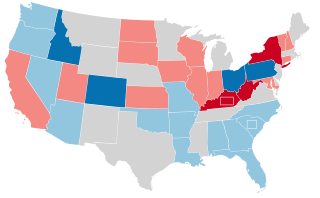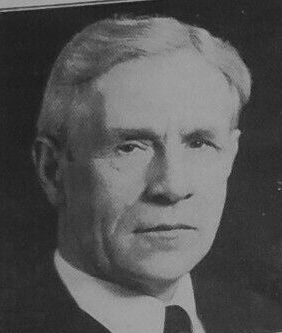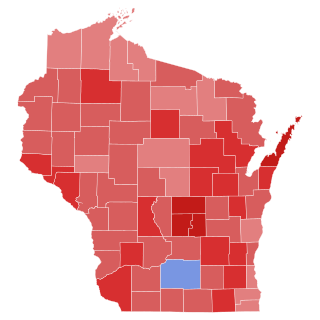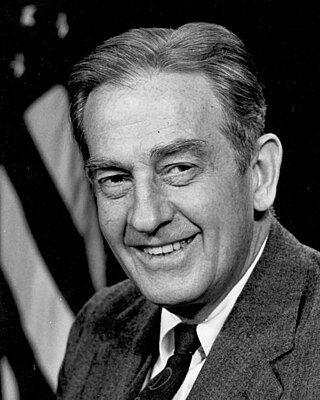
Alexander Wiley was an American politician who served four terms in the United States Senate for the state of Wisconsin from 1939 to 1963. When he left the Senate, he was its most senior Republican member.

The 1976 United States Senate elections was an election for the United States Senate. Held on November 2, the 33 seats of Class 1 were contested in regular elections. They coincided with Democrat Jimmy Carter's presidential election and the United States Bicentennial celebration. Although almost half of the seats decided in this election changed parties, Carter's narrow victory did not provide coattails for the Democratic Party. Each party flipped seven Senate seats, although, one of the seats flipped by Democrats was previously held by a Conservative.

The 1972 United States Senate elections were held on November 7, with the 33 seats of Class 2 contested in regular elections. They coincided with the landslide re-election of Republican President Richard Nixon. Despite Nixon's landslide victory, Democrats increased their majority by two seats. The Democrats picked up open seats in Kentucky and South Dakota, and defeated four incumbent senators: Gordon Allott of Colorado, J. Caleb Boggs of Delaware, Jack Miller of Iowa, and Margaret Chase Smith of Maine. The Republicans picked up open seats in New Mexico, North Carolina, and Oklahoma, and defeated one incumbent, William B. Spong Jr. of Virginia.

The 1970 United States Senate elections was an election for the United States Senate. It took place on November 3, with the 33 seats of Class 1 contested in regular elections. Special elections were also held to fill vacancies. These races occurred in the middle of Richard Nixon's first term as president. The Democrats lost a net of three seats, while the Republicans and the Conservative Party of New York picked up one net seat each, and former Democrat Harry F. Byrd Jr. was re-elected as an independent.

The 1964 United States Senate elections were held on November 3. The 33 seats of Class 1 were contested in regular elections. Special elections were also held to fill vacancies. They coincided with the election of President Lyndon B. Johnson by an overwhelming majority, to a full term. His Democratic Party picked up a net two seats from the Republicans. As of 2023, this was the last time either party has had a two-thirds majority in the Senate, which would have hypothetically allowed the Senate Democrats to override a veto, propose constitutional amendments, or convict and expel certain officials without any votes from Senate Republicans. In practice, however, internal divisions effectively prevented the Democrats from doing so. The Senate election cycle coincided with Democratic gains in the House in the same year.

The 1956 United States Senate elections were elections for the United States Senate that coincided with the re-election of President Dwight D. Eisenhower. The 32 seats of Class 3 were contested in regular elections, and three special elections were held to fill vacancies. Although Democrats gained two seats in regular elections, the Republicans gained two seats in special elections, leaving the party balance of the chamber unchanged.

Thomas Edward Fairchild was an American lawyer and judge. He served forty years as a judge of the United States Court of Appeals for the Seventh Circuit. Earlier in his career he was a justice of the Wisconsin Supreme Court, United States Attorney for the Western District of Wisconsin, and the 31st Attorney General of Wisconsin.

Howard Johnstone McMurray was a U.S. Representative from Wisconsin, educator, and businessman.
The Wisconsin Progressive Party (1934–1946) was a political party that briefly held a dominant role in Wisconsin politics.

The 1944 United States Senate election in Washington was held on November 7, 1944. Incumbent Democratic U.S. Senator Homer Bone resigned in April, having been appointed and confirmed to the United States Court of Appeals for the Ninth Circuit in April. Democratic U.S. Representative Warren Magnuson won the open race over Republican Harry Cain, the mayor of Tacoma and was appointed to the vacant seat.

The 1962 United States Senate election in Wisconsin was held on November 6, 1962. Incumbent Republican U.S. Senator Alexander Wiley ran for re-election to a fifth term in office but was defeated by Democratic Governor Gaylord A. Nelson.

The 1946 United States elections were held on November 5, 1946, and elected the members of the 80th United States Congress. In the first election after World War II, incumbent President Harry S. Truman and the Democratic Party suffered large losses. After having been in the minority of both chambers of Congress since 1932, Republicans took control of both the House and the Senate.

The 1938 United States Senate election in Wisconsin was held on November 8, 1938. Incumbent Democratic U.S. Senator F. Ryan Duffy ran for a second term in office. In a three way race, Alexander Wiley defeated Duffy and Lieutenant Governor Herman L. Ekern.

The 1938 United States Senate election in Iowa took place on November 8, 1938. Incumbent Democratic Senator Guy M. Gillette, who won a special election to complete the unexpired term of Richard Louis Murphy, won a full term in office by defeating Republican former Senator Lester J. Dickinson. Gillette and Dickinson had briefly served together in the final months of 1936.

The 1956 United States Senate election in Wisconsin was held on November 6, 1956. Incumbent Republican U.S. Senator Alexander Wiley was re-elected to a fourth term in office. He survived a close primary challenge from U.S. Representative Glenn R. Davis before defeating Henry Maier in the general election. This election marks the last Senate election in Wisconsin to date in which the Republican candidate won Milwaukee County.

The 1950 United States Senate election in Wisconsin was held on November 7, 1950. Incumbent Republican U.S. Senator Alexander Wiley was re-elected to a third term in office over Thomas E. Fairchild.

The 1946 United States Senate election in Wisconsin was held on November 5, 1946.

The 1952 United States Senate election in Wisconsin was held on November 4, 1952.

The 1922 United States Senate election in Indiana took place on November 7, 1922. Incumbent Republican U.S. Senator Harry Stewart New ran for re-election to a second term in office, but was defeated in the Republican primary by former Republican Senator Albert J. Beveridge. In the general election, Beveridge was defeated by Democratic former Governor of Indiana Samuel M. Ralston.

The 1972 United States Senate election in New Jersey was held on November 7, 1972. Incumbent Republican Clifford P. Case defeated Democratic nominee Paul J. Krebs with 62.46% of the vote.























